Malaysia
![]()
This article is about the state; for the television films, see The Dream Hotel - Malaysia and The Dream Ship: Malaysia.
Malaysia [maˈla͜izi̯a], less commonly Malaysia, is an elective constitutional monarchy of 32 million people consisting of 13 states in Southeast Asia on the Malay Peninsula, or West Malaysia, with its capital at Kuala Lumpur, and East Malaysia on part of the island of Borneo. Between the two roughly equal parts of the country lies the South China Sea.
The Malay Peninsula borders Thailand by sea and land and has maritime borders with Vietnam, Singapore and Indonesia. To the south, it is separated from the Indonesian island of Sumatra by the Strait of Malacca and connected by a causeway to the city-state of Singapore on the island of the same name. East Malaysia has a land and sea border with the Sultanate of Brunei to the north and with Indonesia to the south, and has maritime borders with Vietnam and the Philippines.
Malaysia was formed in 1963 from four former parts of the British Empire: the Federation of Malaya, the Crown Colony of North Borneo, the Crown Colony of Singapore (until 1965) and the Colony of Sarawak.
The head of state is the king. He bears the title Yang di-Pertuan Agong and is elected every five years from a line of nine nobles. Parliament has an upper and lower house based on the English model. From its inception until 2018, the majority coalition Barisan Nasional led by the United Malays National Organisation party led both chambers. In 2018, the opposition Pakatan Harapan alliance replaced the previous government, providing the prime minister for the first time.
Malaysia is a founding member of the Association of Southeast Asian Nations (ASEAN) and is considered an emerging economy.
Geography
Geology
From the swamp and coastal forests of the alluvial plains by the sea (partly overgrown with mangroves), the land rises significantly everywhere: On the Malay Peninsula to broadly unfolded mountain ranges to the north, consisting of parallel zones of mountains and hills. The main ridge reaches up to 2190 m above sea level. In Sarawak to a plateau with individual mountain ranges and in Sabah to a strongly indented high mountain range, in which rises with the 4,095 m high Kinabalu, the highest mountain between the Himalayas and New Guinea. Also on Borneo is the Sarawak Chamber, the largest known cave room in the world. Malaysia's largest island is Pulau Banggi, which lies off the northern tip of Borneo and is part of the Kudat district in the state of Sabah. To the northeast, off the coast of Borneo, are the Turtle Islands, around which the Turtle Islands Park of Sabah National Park was established in 1976.
Climate
Malaysia lies entirely in the humid, hot and humid tropics: Accordingly, the daily and annual temperature differences are very low at 2 °C, there is a high relative humidity of 98 % in the morning and over 65 % in the afternoon and the average annual rainfall is high to very high at 2000 (lowlands in the west) over 4000 mm (northeast under monsoon influence) to 6000 mm (mountains) rain. Temperatures are in the range of 25 to 28 °C throughout the year. From April to October the southwest monsoon and from October to February the northeast monsoon dominates the weather.
The four climate diagrams result in a west-east profile: Kuala Terengganu and Kuala Lumpur are located on the peninsula (West Malaysia), Sandakan and Kuching on Borneo (East Malaysia).
· 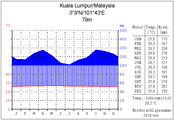
Kuala Lumpur
(Malacca West)
· 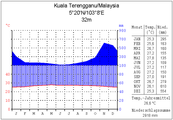
Kuala Terengganu
(Malacca East)
· 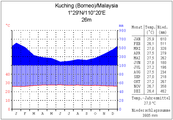
Kuching
(Borneo West)
· 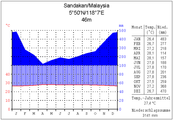
Sandakan
(Borneo East)
Ecology
Both the Malay Peninsula and Malaysian Borneo were originally almost entirely covered by evergreen tropical moist forests: lowland and mountain rainforests up to an altitude of 2000 m, and cloud and cloud forests above that. At the beginning of the 21st century, tropical forests still occupy more than half of the country's land area. Almost half of this forest cover is in Sarawak. The valuable tropical timber in the lowland and lowest mountain ranges and slash-and-burn agriculture by the growing populations of indigenous ethnic groups (especially in inland Sarawak) are increasingly leading to overexploitation and degradation of the forests.
The forest stands in Sabah and Sarawak on Borneo are among the oldest primeval forests in the world. The forests of Mount Kinabalu in particular are therefore characterised by outstanding biodiversity (North Borneo is one of five centres of the greatest biodiversity on earth). With a generally high level of biodiversity, an exceptionally large number of endemic species, genera and families ofplants and animals, and large ecosystems, the whole of Malaysia is one of the world's megadiverse countries. Gibbons, macaques, Malaysian bears and numerous reptiles such as cobras and pythons are widespread. Rarer species include elephants, tigers, clouded leopards, golden and marbled cats and leopards. Borneo is home to the orangutan, which is classified as a critically endangered species. Also endangered is the Sumatran rhinoceros. The species-rich birdlife includes hornbills, beos, parrots, pheasants and owls. Malaysia is also listed as a biodiversity hotspot due to the high level of endangerment.
The commercial and financial centre is the capital Kuala Lumpur, where the federal parliament has its seat. Most government institutions, on the other hand, are located in Putrajaya, which was built in 1995 as the new administrative capital. Other important cities are George Town, Ipoh and Johor Bahru.
Tanjung Piai, located in the southern state of Johor, is the southernmost point of mainland Asia. The Strait of Malacca is one of the busiest shipping routes as a sea route.
See also: National parks and protected areas in Malaysia and List of cities in Malaysia
Population
| Population development | |||
| Year | Population | Year | Population |
| 1950 | 6.110.000 | 1990 | 18.038.000 |
| 1955 | 7.040.000 | 1995 | 20.496.000 |
| 1960 | 8.157.000 | 2000 | 23.186.000 |
| 1965 | 9.527.000 | 2005 | 25.659.000 |
| 1970 | 10.804.000 | 2010 | 28.112.000 |
| 1975 | 12.162.000 | 2019 | 31.950.000 |
| 1980 | 13.798.000 | 2030 | 36.815.000 |
| 1985 | 15.599.000 | 2050 | 41.729.000 |
Ethnic groups
→ Main article: Demography of Malaysia
The population of Malaysia is composed as follows: 50.4% are Malays, 23.7% Chinese, 11% indigenous peoples (Orang Asli and Dayak), 7.1% Indians and 7.8% others.
The population is not evenly distributed throughout Malaysia, as only about 5 million people (about 20% of Malaysia's population) live in the eastern part of Malaysia, i.e. the two states of Sarawak and Sabah on the island of Borneo, although the two states together account for about 60% of Malaysia's land area, while the remaining 80% of the population (about 22 million people) live in the smaller western part of the country.
The Malays, who largely belong to Sunni Islam, have claimed political leadership since Malaysia's independence; they are systematically promoted by the government and given preferential treatment in the civil service, which has been ensured by the so-called Bumiputra status since the introduction of the Malaysian new economic policy in the 1960s. Furthermore, overseas Chinese make up about a quarter of the population. They currently still dominate in the cities. The Chinese play a significant role in trade and commerce. Another seven percent of the population is of Indian origin. These are Hindus, Muslims, Sikhs, Christians or Buddhists. About 85% of Malaysia's Indian-origin population are Tamils, with minority groups being the Malayalis, Punjabis and Telugus.
In the sparsely populated East Malaysian states of Sarawak and Sabah, indigenous ethnic groups who are not ethnic Malays make up half and two-thirds of the population respectively. Like the Malays, they are counted as part of Malaysia's original population and are thus also considered Bumiputras. These indigenous ethnic groups are collectively referred to as Dayak in Sarawak and include the Iban and the Bidayuh, among others. In Sabah live indigenous ethnic groups such as the Murut or the Kadazan.
On the Malay Peninsula, indigenous people also exist, but in smaller numbers, they are referred to by the collective term Orang Asli. These belong to a large number of ethnic groups, but have cultural commonalities. They were followers of animist local religions until the 20th century. Since then, many have converted to Christianity or Islam. Although the Orang Asli differ from the Malays in terms of culture, many have assimilated Malay culture, such as by moving to the cities or by marriage. Some groups of Temiar Senoi have retreated to the inaccessible mountain rainforests of north-central Malaysia, where they live as isolated peoples.
Notable minorities are the Europeans, people from the Middle East, Cambodia and Vietnam. The Europeans are mostly British and some Portuguese whose ancestors have lived there since colonial times. Most Cambodians and Vietnamese came to Malaysia as Vietnam War refugees.
In total (as of 2021), about four to six million immigrants live in Malaysia. Most of the labour migrants come from Nepal, Bangladesh, Indonesia or Myanmar.
Population growth is relatively high at about 1.6% per year, and about one-third of the population is under 15 years old. The urbanization rate is about 75 %. The average life expectancy from 2010 to 2015 was 74.7 years (men: 72.6 years, women: 77.1 years) the infant mortality rate was about 13 per thousand. The average age in 2016 was 28.2 years. A woman had an average of 1.9 children, which is why the population will age significantly in the future.
Languages
The official language of Malaysia is Bahasa Malaysia (Malay). The English language enjoys a special role due to the long British colonial period in Malaysia and is a second language for many Malaysians. Due to a large Chinese minority, Chinese also plays an important role (especially Cantonese, High Chinese, Hokkien, Hakka, Chaozhou (Teochew), Hainan, the Fuzhou dialect). Due to the Indian minority also living in Malaysia, numerous Indian languages, especially Tamil, Telugu and Malayalam are widely spoken. A large number of indigenous languages are also spoken in East Malaysia, the most important of which are Iban and Kadazan. A total of 140 different languages and idioms are spoken in Malaysia.
British English is used in official documents. However, American English has already made some inroads through television. The English used in the colloquial language in Malaysia is very different from British English and is therefore also called Manglish. It is very similar to the Singlish spoken in Singapore except for some slang expressions.
Religions
Overview
All world religions are represented in Malaysia in significant numbers.
Censuses show roughly the following population proportions by religion:
| Year | Islam | Buddhism | Christianity | Hinduism | Chinese folk religions such as Daoism, Confucianism | Non-Denominational | Other confessions or no information |
| 2000 | 60,4 % | 19,2 % | 9,1 % | 6,3 % | 2,6 % | 2,4 % | |
| 2010 | 61,5 % | 19,6 % | 9,2 % | 6,3 % | 1,3 % | 0,7 % | 0,5 % |
The Chinese are mostly Buddhists (20%) or belong to other Chinese religions such as Daoism or Confucianism (2.6%). Christians (9 %) are found in all ethnic groups. Indians consist of Hindus and Sikhs (6.5 %).
Islam
Islam, which 60% of the population professes, is the state religion. The Shāfiʿite school of Sunni Islam
is practiced in theology and jurisprudence. Other Islamic schools, especially Shiite schools, are prohibited.
Malaysia first came into contact with Islam through Arab traders and merchants as early as the end of the 7th century. However, at that time various Buddhist and Indian-Hindu kingdoms prevailed in Malaysia, so that Muslims never made up more than 10% of the population until the 14th century. From the 13th century onwards, more Arabs settled in Malaysia, eventually mixing with the indigenous population and thus furthering the Islamization of the Malays. Like Indonesia, Malaysia was Islamized in the 14th and 15th centuries.
Until well into the 1970s, many Muslim Malays were considered liberal (similar to the Abangan in present-day Indonesia). However, with the Dakwah, an Islamic revivalist movement, a wave of Islamization began (triggered by various ethnic and social conflicts, see among others Parti Islam Se-Malaysia and Al-Arqam), so that Malaysia today is orthodox Islamic. Malays, who make up 50.4% of the total population, are virtually all Muslims. About 70% of Malaysian women of Malay origin wear headscarves. Traditional Malay clothing of Islamic origin is also worn by many Malays.
According to the country's constitution, all ethnic Malays are automatically Muslims by birth. They cannot marry people of other faiths. Apostasy from Islam is highly disliked and in practice is difficult. To do so, a "Borang Keluar Islam" (form for leaving Islam) must first be filled out. Afterwards it has to be proved for about two years that one cannot be converted to Islam after all, for example in "re-education centres", where those who want to leave are detained. Ultimately, a Sharia court must decide on the resignation - the freedom of religion guaranteed in the constitution exists only in theory. This is also shown by cases from 2007.
Christianity
The Council of Churches of Malaysia is an ecumenical organization representing the Christian churches and affiliated groups in Malaysia. The Christian press can only be published in Malay with difficulty, but is readily available in English, Chinese and Tamil. Unrestricted is the distribution of writings to members of associations or churches. Attempts at censorship (specifically: banning the word "Allah") were made by the government here as well, which was initially overturned by a court, but reintroduced in 2013. In January 2014, the Islamic religious office JAIS made headlines when it entered the premises of the Bible Society of Malaysia without any legal basis and with police support and confiscated 300 copies of the Al-Kitab, the Bible written in Malay.
The building of churches often leads to difficulties with the planning authority in conurbations.
Education
See also: Education system in Malaysia and List of universities and colleges in Malaysia
The education system in Malaysia is under the Ministry of Education (Kementerian Pendidikan Malaysia). It is divided into two main departments, of which the Education Sector deals with all matters relating to pre-schools, primary and secondary schools, while the Higher Education Sector is responsible for higher education. Although education policy is the responsibility of the federal government, each Malaysian state has its own Ministry of Education. The legal basis for state education policy is the Education Act 1996.
Malaysia has a public school system that guarantees free, multilingual education for all citizens. In addition, there is the option of attending a private school or participating in homeschooling. Compulsory education is limited to primary level. As in many Asia-Pacific countries, such as South Korea, Singapore and Japan, the curricula and final examinations follow a uniform system across schools.
In 2015, the literacy rate in Malaysia was 94.6% of the adult population. For females, it was 93.2% and for males, 96.2%. In the 2015 PISA ranking, the country's students ranked 45th out of 72 countries in mathematics, 51st in science, and 46th in reading comprehension.

Mosque in Kota Kinabalu, Sabah

Malacca church
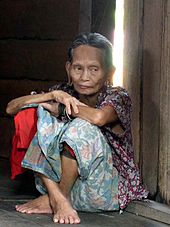
Penan woman in Sarawak

Population pyramid Malaysia 2016

Population density Malaysia 2010
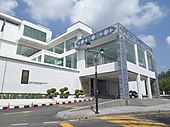
Islamic Museum in Kuala Lumpur
Questions and Answers
Q: What is Malaysia?
A: Malaysia is a federal constitutional monarchy located in Southeast Asia. It consists of thirteen states and three federal territories, separated by the South China Sea into two regions, Peninsular Malaysia and Borneo's East Malaysia.
Q: What are the two main regions of Malaysia?
A: The two main regions of Malaysia are Peninsular Malaysia and Borneo's East Malaysia.
Q: What is the capital city of Malaysia?
A: The capital city of Malaysia is Kuala Lumpur.
Q: Where is the seat of the legislative branch located?
A: The seat of the legislative branch is located in Kuala Lumpur, which also serves as the national capital and largest city in the country.
Q: Where is the administrative capital located?
A: The administrative capital, which represents both executive and judicial branches, is located in Putrajaya.
Q: How many people live in Malaysia?
A: There are over 110 million people living in Malaysia, making it one of world's 43rd-most populous countries.
Q: What languages are spoken in Malaysian Borneo and on its peninsula?
A Malay written with Latin alphabet is its official language; English has been recognised as an official language only in Sarawak state along with Malay; Tamil and Chinese are also often used; there are over 130 other languages spoken throughout Malaysian Borneo (94) and on its peninsula (40).
Search within the encyclopedia